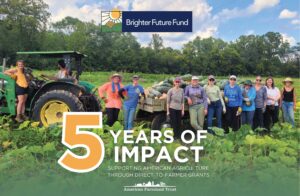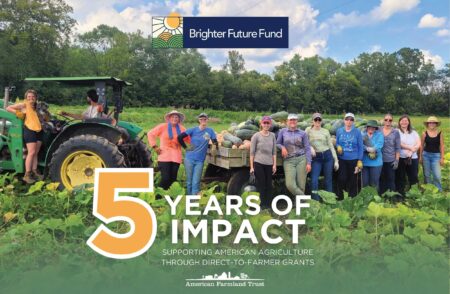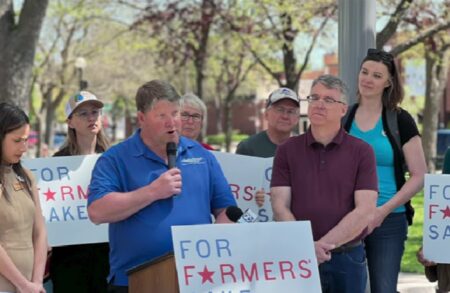The Agriculture Department will soon roll out the second stage of the Supplemental Disaster Relief Program. We asked Richard Fordyce, undersecretary of agriculture for farm production and conservation, about the program and when — or if — the trade aid payments previously teased by the administration will be announced.
Plus, Joby Young outlines what’s included for agriculture in the deal lawmakers struck to reopen the government and Dan Halstrom with the U.S. Meat Export Federation discusses the impact of the U.S.-China trade deal for the meat industry. Emily Skor with Growth Energy also weighs in on the biofuel sector’s continued push for year-round E15 and what she expects from the EPA’s Renewable Volume Obligations.
Watch the Video
Want to receive Newsmakers in your inbox every week? Sign up!
Read the Transcript
Please note: This transcript has not been edited.
Lydia Johnson: Welcome to Agri-Pulse Newsmakers, where we aim to take you to the heart of ag policy. I’m your host, Lydia Johnson. We’re bringing you a special edition of the show this week from the National Association of Farm Broadcasting annual convention in Kansas City. Hundreds of ag industry leaders gathered to share the latest updates on issues important to farm country like biofuels, trade, and conservation.
Richard Fordyce, USDA Under Secretary for Farm Production and Conservation
The Agriculture Department is preparing to roll out the second stage of the supplemental disaster relief program. We asked Richard Fordyce, under secretary of agriculture for farm production and conservation, about how USDA is planning to roll out the program.
Richard Fordyce: The SDRP stage two announcement that happened on Monday is kind of the final piece of that American Relief Act money that, you know, that that Congress appropriated the total of 30 billion. At the beginning was that was that economic relief, the 10 billion. And then we had SDRP stage one, and now this SDRP stage two. So once we’re finished with SDRP stage two, you know, we should be able to have been able to get that relief out, that $30 billion relief out to farmers across the country. So I think it’s been a while ago, long enough ago that folks maybe not, don’t remember, you know, what the SDRP two funding was. But you ask about SDRP two and that is an approach that will support agriculture, support farmers that were uninsured. Also, for the first time, a disaster program that is, is attempting to capture shallow losses. And so shallow losses are, you know, situations for, for crops that did not they weren’t very good, but they didn’t hit that level of indemnity. So when they did not get an indemnity, but they were very close. And so, in this program, we’ve got formulas that will be able to calculate how close were you to getting an indemnity and, and potentially be able to make a payment that’s equal to your insurance premiums and some other fees. So it’s going to be a help, for folks that, that didn’t get an indemnity. The big piece of it though, or the folks that were not insured. And so we really feel pretty strongly that that’s going to be, a pretty high percentage of the folks that will be able to engage in this program will be specialty crop producers that either insurance products aren’t available or they just don’t work well for them. And so that, that uninsured kind of population of, of growers are the ones that that is really going to be targeted in SDRP stage two.
Lydia Johnson: This is rolling out right after the government shutdown as governments now reopen, but the longest government shutdown in the country’s history. You know, many USDA staff were furloughed during that shutdown. Well, those staff not working for those 30 some days impact FPAC’s ability to roll out this aid and roll it out quickly.
Richard Fordyce: You know, so the final pieces of the implementation of SDRP two, we were actually doing that during the shutdown. We had folks that were exempt from, being furloughed in order to kind of finish putting the development of the program, you know, getting the regulation through clearance and doing all the things that you have to do to be able to roll out a program. So from a headquarters perspective at FSA, those folks were continuing to work through the shutdown. Shutdown ends, our goal was to be able to announce that at the end of the shutdown. And we were able to meet that goal. And so since we had a lot of folks furloughed, we didn’t have the ability to, for example, train county office people on how to implement SDRP two. So we’re taking this week, two hours a day, every day, all week, to train them on different components of SDRP two. And so by Friday, county office staff, state office folks that support the county offices will be trained. And then, we will start we’ll start talking about and taking applications for SDRP two on Monday.
Lydia Johnson: Very good. The other program that farmers have kind of been waiting on, the administration has teased, is some type of market facilitation program to compensate producers for trade related losses. I mean, when could they expect that, could that possibly be before the end of the calendar year?
Richard Fordyce: So those conversations Lydia, are ongoing. You know, I think that, you know, you know, if we do something when we do something, we want it to be reflective of what’s actually happening in the marketplace. What is that effect on trade and how is that affecting prices? You know, the president was able to secure some agreements with China, on some purchases since that time. You know, we’ve seen an uptick in soybean prices, you know, up to at one point $1.30 more than before the announcements were made. And so taking all of I mean, there is a lot that has to go into that, into that discussion and that calculation. But we want to just make sure that we are being as representative as possible when and if there is a program. You know, the chief economist office is key to, to being able to, you know, gather that data, analyze that data, you know, and present a real, real time picture about where we are. So, so those conversations are continuing.
Lydia Johnson: Okay. So with this waiting and seeing, you know, it could be beyond 2025. There’s no rush to get this out very, very quickly.
Richard Fordyce: I think, you know, I think certainly, you know, the White House, the administration, the president, Secretary Rollins, we all realize that, you know, economically, times are a little tough. You know, in agriculture right now, you know, especially like title one commodity farmers, you know, it’s just, it’s just kind of a tough time and there’s a whole bunch of things that kind of are playing into that. Right? Commodity prices are one piece of that. But input costs on the other side, you know, can be can certainly be a problem when it comes to the margin between what it cost to plant a crop and after harvest, what you got, you know, in the bin. And so I think that, you know, there’s a, there’s a, there’s a lot that goes into this, certainly a lot of moving pieces. There are a lot of moving pieces.
Lydia Johnson: Congress also recently extended the farm bill for another year. I mean, what impact does that have on the conservation reserve program?
Richard Fordyce: So, so conservation reserve program, one of those, you know, I remember when CRP started and now I’m going to call it a legacy program. But, you know, certainly a key piece to conservation, across the, across the landscape, you know, in, in, in rural America, so, so CRP payments started, I think, yesterday or today, going out for this year There’s more than one payment run. Depending on how the what the contract is, what kind of CRP contract it is. Those are bunched in different payment runs. But the first payment run I think started yesterday or maybe today. So you know, we’re getting that we’re getting that rolled out. You know one of the things that that has complicated just about everything that we do is that the, the government shutdown started on what would have been the first day of the new fiscal year. And so we’ve got and I don’t even know how many, but we’ve got a number of systems that at the start of each fiscal year needed need to be audited. They need to be, you know, checked. And that work is kind of done before any kind of payment runs or any kind of program involvement happens. So really Thursday, in a lot of cases was like the beginning of our fiscal year because that work that needed to be done was done by folks that were furloughed.
Joby Young, Executive Vice President at the American Farm Bureau Federation
Lydia Johnson: The country’s longest recorded government shutdown is now over. We asked Joby Young, executive vice president at the American Farm Bureau Federation, what’s at stake for agriculture in the deal lawmakers struck to reopen the government.
Joby Young: Yeah, well, the main thing, obviously, is the, the extension of the farm bill, those programs that weren’t covered under the one big, beautiful bill.
So, we’re encouraged to see that those getting included of course, you know, we still need to update the farm bill, those programs that that the one big beautiful, beautiful bill didn’t cover. There’s a lot of needed updates with, with, loan limits and, and, conservation programs and rural development and other things. We still need to work on that. And, and we’ll continue to advocate for that too. But it is good to know that, that those programs are extended now. And, and we can move forward with all these other priorities we have, that are, that are still bearing down on us.
Lydia Johnson: One of the things that government shutdown delayed the administration has teased, you know, some kind of market relief payments coming. I mean, farmers seem to be counting on that economic assistance payments with the condition of farm country right now. And looking ahead to planting. Yeah. How much money do you think that farmers might need and how much do you expect the administration to possibly provide?
Joby Young: Yeah, well, I don’t have a hard and fast number. We know it’s many billions of dollars, you know, out there for various, industries throughout Ag. There’s a lot of, challenges in agriculture right now. And we’re seeing, balance sheets across the country upside down. And so, there are, you know, estimates are pretty high. And that’s why we’ve been advocating for these bridge payments. You know, the the two lanes, of course, the sort of the trade, lane that the USDA was working on, we saw some, comments from, the secretary, I think yesterday about some timing on that maybe in the next few weeks, next month. I mean, there’s more news about those payments and more. And we’re advocating for those. But of course, the the other piece, the other lane, which is, you know, just the, the reflects the losses that are coming from the, the general farm economy. We’ve seen, you know, four straight years of declining, commodity prices and, high input costs and how that’s really affecting out in the farm economy. So that’s something that’s sorely needed right now across farm country. But of course, that’s just a bridge until we can get to, some of these improvements we’ve seen in our farm programs from the one big, beautiful bill that don’t kick in until until next year. And so that’ll be great to to, to to make it to that point. But we need to make it at that point first.
Lydia Johnson: Yeah. And Farm Bureau was recently at the White House advocating for year round E15. It’s a big priority of farmers. You know, what was the sentiment from that meeting and was the administration perceptive?
Joby Young: Well, we’re really encouraged about where we are on E15, of course, where, you know, we’re not in the end zone yet, but we’re is about as close as we’ve ever been, at least since I’ve been working on these, on these issues, which have been for a number of years. And so we’re kind of right at the end zone and, and we’re trying to push it through, every way we can. And so there’s a lot of, you know, conversations in the White House complex going on. We were part of that, and encouraged by folks trying to find a way, find a path forward, find, agreement on and what that looks like. But that would be that would be huge.
Lydia Johnson: And as we look ahead to Thanksgiving, Americans are set to spend less on this year’s Thanksgiving dinner. You know, what did the American Farm Bureau Federation find in your annual survey, and how did those costs vary from previous years?
Joby Young: Yeah, sure. So we’ve been doing this survey for 40 years. And so that’s a it’s a pretty interesting project I have for 40 years, volunteer shoppers fanning out across the country and helping us with this informal survey. It is a snapshot in time, you know, and prices of course, they change as you go through the holiday season and, and retailers put specials on and those sorts of things. But what we did see this time when we do it first week in November, was a overall 5%, decline. And that’s primarily driven by turkeys and, and the specials that retailers are putting on frozen turkeys to bring shoppers in the door. And so that drove a lot of those savings. It’s, some, some other, parts of our market basket were up some down, but overall 5% decline. So, shoppers I’m sure will be happy to see that. And if they if they wait to or maybe a little closer to Thanksgiving for their shopping, they might even get a better deal out there.
Dan Halstrom, Meat Export Federation President and CEO
Lydia Johnson: President Trump is moving ahead with a trade deal with China. We asked U.S. Meat Export Federation President and CEO Dan Halstrom what the impact of the deal is for U.S. meat exports.
Dan Halstrom: Yeah. Well, thank you for having me. And, yes, the China this China topic’s, a big one. And I think the recent, call it a thaw in relations is, is a very good first step. But the reality is, especially on the beef side, we still have some formidable, challenges. And we have a de facto ban at the moment, mainly because of the fact that, the CIFER which is their plant registration system, has not been updated with more than 400 US beef establishments. So this is our single largest priority to get those establishments re listed on the on the China CIFER system. But it really doesn’t stop there. In addition to that, we also have quite a few non-tariff trade issues coming up with various residue violations. So there’s quite a few plants have actually been delisted twice. So you have the plant registration, but then you have these non-tariff trade issues as well. So those two items, I mean, $1.6 billion market last year for U.S. beef, one of our fastest growing regions. So, without a doubt, whether it’s with USTR, USDA, that this is the single largest priority, get these plants to be listed.
Lydia Johnson: And some of those beef facility export registrations are expired. It’s possible to renew those in the China deal. You know, what’s the importance of renewing those?
Dan Halstrom: Well, I think, you know, it’s not, you know, 1.6 billion. It was our fastest growing market. But really, there’s additional reasons. I mean, the halo effect to having China in the market versus out on beef, is is, it can’t be understated because, you know, the, the reality is that the competition for product is common throughout Asia. The product mix is very similar. So by having China in the market versus out, you’re going to raise all boats in terms of the value opportunity. So I think, that and they’re demanding our product. I mean the largest single customer for U.S. beef, is Sam’s Club. The very high end, you know, modern retailer, with 50 some, stores throughout the eastern seaboard, right. And they’re ready to go back into U.S. beef. I mean, they’ve had to defer to other sources like Australia and their business has been down significantly. So it’s not like, you know, the consumer side’s entirely different than the political side. They want our product. They want the value. They want the quality. So yeah, we’re like I said, this is a this is a primary focus.
Lydia Johnson: And China is just one country, one example. But President Trump’s tariffs have rippled through many U.S. trading partners. How have exporters in the U.S. responded to these tariffs and what questions concerns that they’ve been bringing to you throughout this whole year?
Dan Halstrom: Yeah, I think that it’s been volatile. A lot of information, you know, a lot of changes, a lot of shifts. But I think if you if you kind of sift through all the noise, the bottom line is that demand is still very, very good, in fact, record breaking in some of these countries. And keep in mind, on the beef side, that’s with the extremely high price level, right? I mean, we hit a record choice cut out, last summer, I think it was in July where we hit almost $420 100 weight on choice all time record. And even with that, some of these markets like a Mexico, like a Central America, like a Columbia, are still buying our products. That wasn’t the case five, ten years ago. You know, prices hit a certain point. They’d stop and then they’d come back in when the prices came down. So I think there’s a real optimism amongst exporters that, you know, the middle class is emerging globally. And this is what we’re seeing. Of course, nobody likes high prices, but that doesn’t mean they’re not going to buy our product. They want the product, they want the quality. So I think that’s the positive.
Lydia Johnson: And these tariffs on some of the US’s closest trading partners, you know, are you concerned about the relationships with those trading partners changing in the future.
Dan Halstrom: Well yeah. On the on the surface yes. But deep down no, I think I think a lot of these partnerships, you know, have been established over decades. You know, I look at the USMCA with Mexico and Canada are probably our two most and closest trading partners, most important. And you know, the agriculture is integrated immensely between Canada, U.S. and Mexico. So I think that’s an example where, you know, we’ll share. It’s been a little rocky with this and that and the back and forth. But the base, the base reality is that the relationships are very, very strong. And I think that’s the case with a lot, especially with these markets where we have existing FTAs.
Emily Skor, Growth Energy CEO
Lydia Johnson: The U.S. harvested a record corn crop this fall. We asked Growth Energy CEO Emily Skor if the record harvest could put pressure on the administration and lawmakers to take action on biofuel policy.
Emily Skor: I certainly hope so. And that is a big part of the conversation in Washington with policymakers and lawmakers right now. Is making sure that they are well aware that the state of the farm economy is such that we need U.S. markets for U.S. commodities. And higher blends of bioethanol like E15, are the solution. So a lot of attention. Educating the Department of Agriculture has been a good champion for us and their conversations as well. And so I am optimistic that this will be recognized with Congress passing legislation and with some final rules coming out of the EPA on biofuel blending next year.
Lydia Johnson: And farm country has long been pushing for year round E15, and given the supply and economic conditions in farm country right now, I mean, could this finally be the year that it really happens?
Emily Skor: It could be. And it might now be early January because the government shut down. It has slowed down a few things. What we need is a vehicle. We need a bill that’s going to pass, and that’s going to be one around government funding. The next opportunity is most likely going to be end of January. And so we’re working very hard to make sure that leadership in the House and the Senate, with Republicans and Democrats, they’re very aware. And it’s really two things. We need markets for U.S. farmers. And with this huge corn crop that, that we have. We also need to make sure that we’re attentive to consumer prices. And so the fact that E15 is a lower cost fuel, you save 10 to $0.30 per gallon every time you fill up. That is also very salient right now for lawmakers.
Lydia Johnson: And, as we look at this issue, the American Petroleum Institute, one of the most influential voices in the oil lobby, recently removed their support for year round E15 for that bill. What would it take to bring back the their support? Or do you think that the bill, if you know, is in Congress, you know, it could happen without their support?
Emily Skor: You know, I’ll be optimistic that we can get them back there. And their opposition isn’t on the merits. This is actually something that I think would be good for the refining sector, though. They will be able to blend more biofuel and generate more credits under the Renewable Fuel Standard. This is about this is a political act. This is something that they know is important to us. They have some things that are priorities for them. And so it’s become kind of they’re resurrecting more of a political conversation. And there’s a lot of good dialog right now with API, with our congressional champions, and even with the White House as well. So I think what’s top of mind is there’s some API concerns, but but I go back to the kind of the overriding concern right now, it’s the farm economy and it’s consumer prices. And for that you will need E15.
Lydia Johnson: Yeah. And renewable volume obligations have also been top of mind. I’m curious, you know, what conversations have you had with the Environmental Protection Agency on those, and what are you hoping to see?
Emily Skor: Ongoing conversation. Earlier this year, EPA came out with a fantastic proposal to blend more biofuel than ever before. In 2026 and 2027. We need them to finalize this rule. They likely won’t do it until maybe early 2026. And there’s a lot of conversation of different stakeholder groups challenging the proposal, but their proposal is solid. It’s more blending. It’s preferential treatment for U.S. feedstock and U.S. fuel and that’s what you want out of out of U.S. law. And, the other thing that you’re seeing out of the agency is they are granting small refinery exemptions. That is something this administration is doing. But importantly for us, they are signaling when we do that, that’s not going to come at the cost of biofuel demand. We will make sure that those numbers, those volume targets will be blended. And that’s a big part of the conversation on reallocating those requirements.
Lydia Johnson: Thanks for joining us for another episode of Agri-Pulse Newsmakers. Looking ahead, next week is Thanksgiving. Tune in next week and check our website any time for the latest developments on all things food, farm and fuel policy for Agri-Pulse, I’m Lydia Johnson. Thanks for watching.
Agri-Pulse is a trusted source in Washington, D.C., with the largest editorial team focused on food and farm policy coverage.












